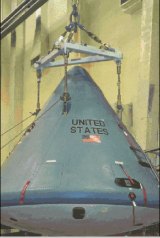NASA In Brief -- Astronauts remembered; public invited to help find planets

NASA's Day of Remembrance honors members of the NASA family who lost their lives while furthering the cause of exploration and discovery.
NASA Administrator Charles Bolden and other agency senior officials will hold an observance and wreath-laying at Arlington National Cemetery. Other tributes across the agency include a wreath-laying ceremony at the Space Mirror Memorial located in the Kennedy Space Center Visitor Complex in Florida. NASA's Ames Research Center at Moffett Field, Calif., will hold a remembrance ceremony at its visitor center.
NASA also is paying tribute to the agency's fallen astronauts with special online content.
PLANET SEARCH: NASA is inviting the public to help astronomers discover embryonic planetary systems hidden among data from the agency's Wide-field Infrared Survey Explorer (WISE) mission through a new website, DiskDetective.org.
WISE was designed to survey the entire sky at infrared wavelengths. From a perch in Earth's orbit, the spacecraft completed two scans of the entire sky between 2010 and 2011. It took detailed measurements on more than 745 million objects, representing the most comprehensive survey of the sky at mid-infrared wavelengths.
Astronomers have used computers to search this haystack of data for planet-forming environments and narrowed the field to about a half-million sources that shine brightly in the infrared, indicating they may be dust-rich disks that are absorbing their star's light and reradiating it as heat.
"Planets form and grow within disks of gas, dust and icy grains that surround young stars, but many details about the process still elude us," said Marc Kuchner, an astrophysicist at NASA's Goddard Space Flight Center in Greenbelt, Md. "We need more examples of planet-forming habitats to better understand how planets grow and mature."
Galaxies, interstellar dust clouds and asteroids also glow in the infrared, which stymies automated efforts to identify planetary habitats. There may be thousands of nascent solar systems in the WISE data, but the only way to know for sure is to inspect each source by eye, which poses a monumental challenge.
Public participation in scientific research is a type of crowdsourcing known as citizen science. It allows the public to make critical contributions to the fields of science, technology, engineering and mathematics by collecting, analyzing and sharing a wide range of data. NASA uses citizen science to engage the public in problem-solving.
SPACE STATION CARGO SHIP ACTIVITIES: The departure of an unpiloted Russian cargo spacecraft and the launch and docking of another to resupply the International Space Station will air live on NASA Television Feb. 3 and Feb. 5.
The ISS Progress 52 cargo craft that arrived at the space station last July will undock from the station at 11:21 a.m. EST Feb. 3 and move away to a safe location where it will undergo tests before its planned entry into Earth's atmosphere on Feb. 11. NASA TV coverage of the undocking will begin at 11 a.m. Scientists will use the spacecraft to study the effects of weightlessness and temperature extremes on its systems.
On Feb. 5, the ISS Progress 54 cargo craft will launch from Kazakhstan at 11:23 a.m. on an expedited, six-hour journey to the space station. NASA TV coverage of the launch will begin at 11 a.m. Progress 54 will dock at 5:24 p.m. NASA TV coverage of docking will begin at 4:45 p.m. The spacecraft is loaded with 2.8 tons of food, fuel and supplies for the crew.
SPACE STATION PROPOSALS SELECTED: NASA's Physical Science Research Program will fund seven proposals to conduct physics research using the agency's new microgravity laboratory, which is scheduled to launch to the International Space Station in 2016.
NASA's Cold Atom Laboratory will provide an opportunity to study ultracold quantum gases in the microgravity environment of the space station -- a frontier in scientific research that is expected to reveal interesting and novel quantum phenomena.
This environment makes it possible to conduct research in a way unachievable on Earth because atoms can be observed over a longer period.
The chosen proposals came from research teams, which include three Nobel laureates, in response to NASA's research announcement. The proposals will receive a total of about $12.7 million over a four- to five-year period. Development of selected experiments will begin immediately.
Five of the selected proposals will involve flight experiments using the Cold Atom Laboratory aboard the space station following ground-based research. For a complete list of the selected proposals, principal investigators and organizations, visit NASA’s website.
Like us on Facebook.
Related:
Spacecraft to give close-up view of comet
NASA invites public to send names on asteroid mission
NASA: Spacecraft comes out of hibernation, spots asteroid
NASA: First asteroid of 2014 spotted
